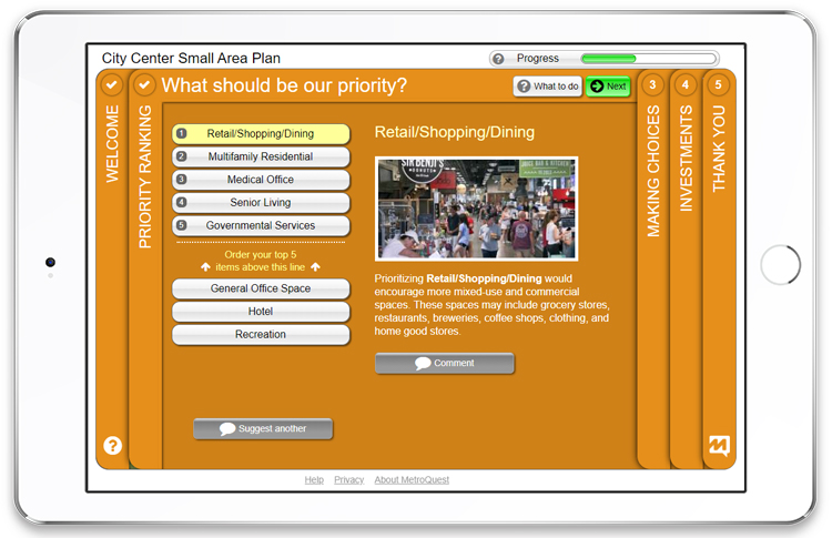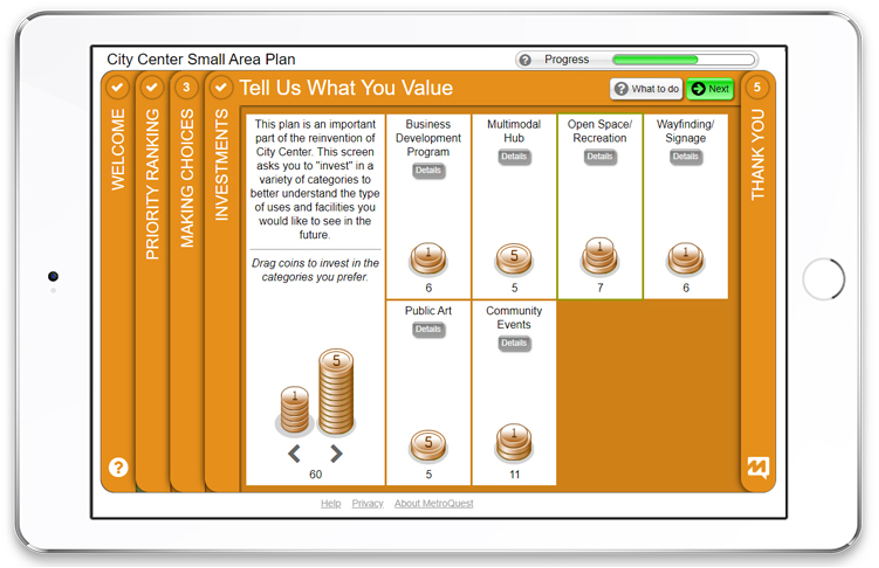[SURVEY OF THE MONTH] Comprehensive Small Area Planning for Stakeholder-First Redevelopment
![[SURVEY OF THE MONTH] Comprehensive Small Area Planning for Stakeholder-First Redevelopment [SURVEY OF THE MONTH] Comprehensive Small Area Planning for Stakeholder-First Redevelopment](https://metroquest.com/wp-content/uploads/SURVEY-OF-THE-MONTH-Comprehensive-Small-Area-Planning-for-Stakeholder-First-Redevelopment.png)
Our Survey of the Month blog series is a way to recognize particularly great examples of community engagement surveys created by MetroQuest subscribers. The series also aims to provide the tools and inspiration for YOU to create your next great survey!
This month, we depart from the topic of transportation to highlight a fantastic comprehensive plan on a smaller scale. Port St. Lucie in Southern Florida is an extremely well-executed survey by our longstanding customer Kimley-Horn. Let’s dive into it!
What’s the story? Port St. Lucie City Center Small Area Plan
For this project, the City of Port St. Lucie is developing a Small Area Plan for its City Center (around 50 acres) and utilized a MetroQuest survey to gather public input to access the understanding of current conditions, to identify future needs and to learn what investments will be required to meet these needs. The goal is to create a multi-year redevelopment project to create a vibrant and walkable destination with retail and dining opportunities as well as hotel and conference center amenities.
To learn more about the project, please visit the project website here.
Anatomy of a Small Area Plan Survey: Using MetroQuest to Identify Priorities for Small Scale Projects
After a short introduction on the first Screen of the Survey that includes a few key features discussed further below, the Port St. Lucie MetroQuest survey utilizes a Priority Ranking Screen to ask participants to rank five items that represent potential elements of the City Centre. Participants choose their favorite five items out of a list of eight, namely (listed in random order): Retail/Shopping/Dining, Senior Living, General Office Space, Multifamily Residential, Medical Office, Recreation, Hotel, and Government Services. By identifying participants’ top five among the items, the Planning and Zoning Department and Community Redevelopment Agency (CRA) can identify the most pressing priorities within the community.
The survey continues with a Tradeoff Screen, presenting 5 topics that help inform the plans for the City Center, namely Neighborhood Design, Intensity, Open Space, Public Facilities, and Transportation. The task for participants is to weigh in on each topic by indicating where their preferences fall on the spectrum between two choices.
The third and final interactive task is a Budget Allocation Screen, where participants are asked to distribute a fictitious budget of $100 across six categories: Business Development Program, Multimodal Hub, Open Space/Recreation, Wayfinding/Signage, Public Art, and Community Events. Each category is further explained so that participants can make an informed decision on where they would prioritize funding and investment. This activity reinforces the idea of budget prioritization for participants, illustrating that resources for the Small Area Plan will be split between different aspects of redevelopment as funds are always limited.
If you’d like to try the survey, visit the demo version here. This version does not collect data and will not affect the survey results.
5 Tips from Port St. Lucie City Center: Make a Big Impact for Your Small Projects
While many of our subscribers use MetroQuest for large scale transportation projects, this survey proves small scale projects, such as urban design plans, can also use online surveys for successful public engagement. Below are 5 takeaways from the survey:
- The Tradeoff Screen is particularly well-suited for design related projects as they often contain, well, tradeoffs. The Screen visually presents choices for multiple categories on spectrums. It helps participants understand that typically, choosing one priority, like a type of development for example, means forgoing another. To learn more, read about using the Tradeoff Screen for education in community outreach!
- On the Budget Allocation Screen, one of the details that has a big impact is the “Details” button that allows the survey team to describe each of the categories in more detail without clogging up the Screen with long blocks of text. This way, you can keep your category names short and to the point but also provide longer explanations for those who wish to learn a bit more before making a decision!
- Another item with big impact is the location pop up on the Welcome Screen. This pop up can be used to provide any kind of supplemental information but is particularly well-suited for a map of the project area, as seen in this survey. This helps participants understand exactly what the project covers geographically.
- The Welcome Screen has another neat feature: the Slide Carousel. At the bottom of the Screen, you can add up to 5 factoids or short pieces of information on the project and the carousel will automatically cycle through them, at the speed you desire. This allows you to present more information without overwhelming the Screen or the participants.
- Last but not least, the exceptionally well-executed Priority Ranking Screen deserves a shout-out. Particularly, each priority description really explains what it would mean if this item was prioritized in the redevelopment plan. For example, the description for Multifamily Residential states that “[p]rioritizing Multifamily Residential would encourage a greater mix of housing types in the area. The intent is to meet the needs and preferences of all existing and potential future residents.” Thorough explanations like this allow for truly informed input!
Congratulations to Kimley-Horn and the whole team involved on creating a fantastic input gathering experience!
For more great tips on how to make the most out of MetroQuest, contact your Customer Experience manager or reach out for more information.
Want to learn more about how you can reliably engage 1000s of participants, regardless of the size of the project? Check out our recent webinar!
How Online Public Engagement Takes Off: Lessons from a Bikeway Study in NC
Watch as a dynamic panel shows us powerful community engagement tactics for any type of project, helping planning teams build a culture of engagement, target key groups, and reach 1000s of participants!



